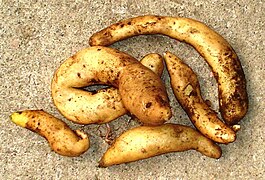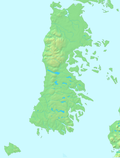Potatoes of Chiloé
 A selection of Chiloé's roughly 400 native varieties of potatoes | |
| Type | Potato |
|---|---|
| Place of origin | Chile |
The
The potatoes of Chiloé are important elements of
Historian Renato Cárdenas and botanist Carolina Villagrán counted about "300 names used for potatoes grown in Chiloé at different times".[4] Local varieties include Bruja morada,[5] Camota,[6] Chochoca,[3] Clavela lisa,[3] Güencha,[7] Pachacoña,[8] Caballera,[9] Cabrita,[citation needed] Cabra,[10] Michuñe Azul,[5][10] Michuñe negra,[3] Michuñe roja,[5][10] Huicaña,[11] Viscocha.[3]
Some potatoes varieties developed abroad have also been introduced to Chiloé, but not all of these have been successful in adapting, despite their putative high yields.[4] Cultivation of the coraíla variety introduced by Servando Coraíl was dominant in the early 20th century, but discontinued when the cultivar was repeatedly struck by potato blight in the 1950s and 1960s.[4]
Preservation efforts of the many varieties began in the 1960s when agronomist Andrés Contreras travelled Chiloé Archipelago in search of small gardens where local elderly women had grown potatoes over many generations.[3] At present Austral University of Chile in Valdivia hosts a gene bank of the potatoes of Chiloé.[3]
Guaitecas Archipelago
Some of the potatoes of Chiloé also grow in the wild in
Potatoes grow beside the sea in a herbaceous zone. The wild potatoes that grow in the archipelago are mostly found in its western part. Apparently these potatoes do not reproduce by seeds and rarely produce flowers and fruits.[12] Potatoes grow in zones of disturbance, mainly in the herbaceous zone near the coast that is affected by winter storms.[12]
-
Guadachos variety
-
Michuñe Blanca variety
-
Michuñe Roja variety
References
- ^ hdl:10925/320. Retrieved 6 December 2009.
- ^ Using DNA, scientists hunt for the roots of the modern potato, January 2008
- ^ a b c d e f g h i Johanson, Mark (August 28, 2020). "Mash hits: the land that spawned the supermarket spud". The Economist. Retrieved September 1, 2020.
- ^ a b c Cárdenas & Villagrán 2005, p. 26.
- ^ a b c Ortiz, Bernardita (September 16, 2019). "El ingrediente: papa chilota". La Tercera (in Spanish). Retrieved September 2, 2020.
- ^ Cárdenas & Villagrán 2005, p. 109.
- ^ Cárdenas & Villagrán 2005, p. 172.
- ^ Cárdenas & Villagrán 2005, p. 263.
- ^ Cárdenas & Villagrán 2005, p. 102.
- ^ a b c Effect of the storage temperature and time on native potato quality
- ^ Cárdenas & Villagrán 2005, p. 186.
- ^ S2CID 6759459.
- ^ Bird, Junius (1946). "The Alacaluf". In Steward, Julian H. (ed.). Handbook of South American Indians. Bulletin 143. Vol. I. –Bureau of American Ethnology. pp. 55–79.
- Bibliography
- Cárdenas Álvarez, Renato; Villagrán Moraga, Carolina (2005). Chiloé: Botánica de la cotidaniedad (in Spanish). Centro Cultural Castro. Link to PDF




